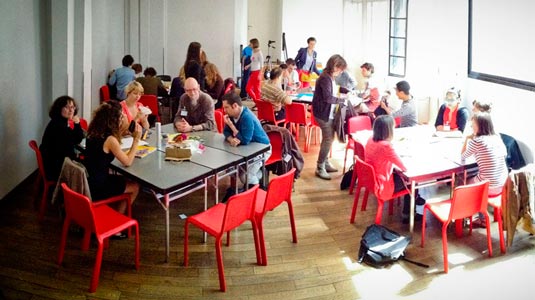5 top tips for giving design feedback
How do you give feedback on colleagues' designs without crushing their feelings? Jerry Cao offers some tips.

Understanding the psychology behind social interactions is a job in itself, but when you're focused on icons, grids, interactions, it's easy to overlook that other people have feelings that need protecting – and that you do, too.
Feedback is a necessary evil for creating the end product that satisfies users, but it serves its purpose more efficiently with a proper procedure in place.
Below, we've collected some feedback tips from design experts on both sides. We've listed them out to help you draw out the beneficial points of feedback while minimizing the harmful ones. Without further delay, here are 5 tips for design feedback that people won't hate.
01. Don't shy away from follow-up questions
Feedback should open a discussion, not just be given and then everyone moves on. This makes it seem like a command, which proper critique is not. Asking follow-up questions creates a dialogue that accomplishes several goals.
For starters, it draws out the critique – by understanding every corner, the recipient better comprehends the problem, and if and which parts of it can be solved.
Additionally, probing with follow-up questions can challenge critiques that are suspect. In settings like this, feedback isn't always honest, there are hidden agendas and personal motives at play. Follow-up questions help sift through what is valid and what falls apart under pressure.
There's not always a devious undertone, though. Sometimes, the critic actually has a valid point, but can't, for whatever reason, articulate it. In this case, asking follow-up questions will aid the speaker in actually voicing what they want to say. Some people simply need help expressing themselves properly.
Get the Creative Bloq Newsletter
Daily design news, reviews, how-tos and more, as picked by the editors.
Dustin Curtis recommends forcing yourself to ask the critic at least three questions. He points out that the act of formulating those questions will help you change your own opinion, making this an advantageous tactic for everyone.
02. Always stay goal-oriented
As we described in Design Collaboration in the Enterprise, a lot of the trouble with feedback comes from confusion over the end-goal.
Who is this product designed for? What does it hope to accomplish? The same design element can be either a perfect choice or an awful choice depending on the answers to these kinds of questions.
If the same goals aren't understood by everyone at the beginning, the feedback will be misguided and ineffective.

Ideally, the goals are decided at the start of the project, but if these were never uniformly addressed, the sooner the better. Once everyone is on the same page about the target users, strategies, styles, and criteria for success, the feedback will be more focused and helpful.
Otherwise, everyone's pulling the design into different directions, and you'll end up with something that tries to fulfill every criteria and satisfies none.
Take the time to reiterate the project goals beforehand. If anyone goes off track, you can more easily bring them back this way. Moreover, clearly established goals will more concretely weed out the valid comments from the opinionated ones, and help in clearing up some disagreements.
03. Provide proper context with framing
If implemented by everyone, proper framing can resolve a good portion of feedback problems. What we mean by framing is the approach or angle in which a comment is presented. The same problem can be framed from a variety of angles, but some are more helpful than others.
Yotam Troim suggests presenting a problem instead of a solution. By framing a critique as an issue, feedback sessions take a whole new feel.Let's take, for example, something simple like colour choice.
A proper way to frame the comment would be something like, "I'm not sure the colour scheme fits the mood of the product." What this does is open a discussion to the group: does this colour scheme actually fit, what is the mood of the product, which colour scheme would work best, etc.

These are all important questions brought to light by the way in which the comment was posed. Furthermore, now the entire group is able to give their opinion on the colour scheme instead of just the first person, and an impromptu brainstorming session begins that incorporates everyone's expertise.
Compare that scenario to one where the comment was framed only as a solution, "I think the colour scheme should be green-blue." All the helpful discussion from the first scenario is bypassed, and it now becomes only a question of whether or not green-blue would work.
Now, let's say the table immediately agrees that green-blue does not work and everyone moves on. The heart of the comment – the colour scheme isn't working – goes unaddressed simply because the speaker framed his critique from a perspective of personal opinion.
Next page: phrase your feedback strategically and always have the facts...

Thank you for reading 5 articles this month* Join now for unlimited access
Enjoy your first month for just £1 / $1 / €1
*Read 5 free articles per month without a subscription

Join now for unlimited access
Try first month for just £1 / $1 / €1

The Creative Bloq team is made up of a group of art and design enthusiasts, and has changed and evolved since Creative Bloq began back in 2012. The current website team consists of eight full-time members of staff: Editor Georgia Coggan, Deputy Editor Rosie Hilder, Ecommerce Editor Beren Neale, Senior News Editor Daniel Piper, Editor, Digital Art and 3D Ian Dean, Tech Reviews Editor Erlingur Einarsson, Ecommerce Writer Beth Nicholls and Staff Writer Natalie Fear, as well as a roster of freelancers from around the world. The ImagineFX magazine team also pitch in, ensuring that content from leading digital art publication ImagineFX is represented on Creative Bloq.
